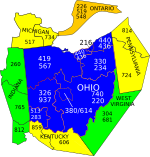New Indianola Historic District
1985 establishments in OhioColumbus, Ohio stubsColumbus Register propertiesColumbus metropolitan area, Ohio Registered Historic Place stubsHistoric districts in Columbus, Ohio ... and 4 more
Historic districts on the National Register of Historic Places in OhioNRHP infobox with nocatNational Register of Historic Places in Columbus, OhioUse mdy dates from August 2023

The New Indianola Historic District is a historic district in the Weinland Park and Indianola Terrace neighborhoods in Columbus, Ohio's University District. The site was listed on the National Register of Historic Places in 1985 and the Columbus Register of Historic Properties in 1987.The district was platted in 1916, and all but two of its structures were built by 1921 (as of 1987). Most are two-story houses with brick exteriors, many with porches.
Excerpt from the Wikipedia article New Indianola Historic District (License: CC BY-SA 3.0, Authors, Images).New Indianola Historic District
East 9th Avenue, Columbus
Geographical coordinates (GPS) Address Nearby Places Show on map
Geographical coordinates (GPS)
| Latitude | Longitude |
|---|---|
| N 39.992958 ° | E -82.998295 ° |
Address
East 9th Avenue 1451
43201 Columbus
Ohio, United States
Open on Google Maps









